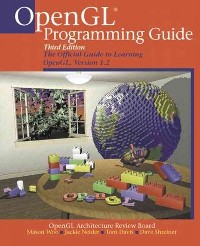简介
"OpenGL is a powerful software interface used to produce high-quality computer generated images and interactive applications using 2D and 3D objects and color bitmaps andimages."--BOOK JACKET. "The OpenGL Programming Guide, Third Edition, provides definitive and comprehensive information on OpenGL and the OpenGL Utility Library. Thisbook discusses all OpenGL functions and their syntax and shows how to use those functions to create interactive applications and realistic color images."--BOOK JACKET
目录
What This Guide Contains
What's New in This Edition
What You Should Know Before Reading This Guide
How to Obtain the Sample Code
Nate Robins' OpenGL Tutors
Errata
Style Conventions
Acknowledgments
Figures
Tables
Examples
Introduction to OpenGL
What Is OpenGL?
A Smidgen of OpenGL Code
OpenGL Command Syntax
OpenGL as a State Machine
OpenGL Rendering Pipeline
Display Lists
Evaluators
Per-Vertex Operations
Primitive Assembly
Pixel Operations
Texture Assembly
Rasterization
Fragment Operations
OpenGL-Related Libraries
Include Files
GLUT, the OpenGL Utility Toolkit
Animation
The Refresh That Pauses
Motion = Redraw + Swap
State Management and Drawing Geometric Objects
A Drawing Survival Kit
Clearing the Window
Specifying a Color
Forcing Completion of Drawing
Coordinate System Survival Kit
Describing Points, Lines, and Polygons
What Are Points, Lines, and Polygons?
Specifying Vertices
OpenGL Geometric Drawing Primitives
Basic State Management
Displaying Points, Lines, and Polygons
Point Details
Line Details
Polygon Details
Normal Vectors
Vertex Arrays
Enabling Arrays
Specifying Data for the Arrays
Dereferencing and Rendering
Interleaved Arrays
Attribute Groups
Some Hints for Building Polygonal Models of Surfaces
An Example: Building an Icosahedron
Viewing
Overview: The Camera Analogy
A Simple Example: Drawing a Cube
General-Purpose Transformation Commands
Viewing and Modeling Transformations
Thinking about Transformations
Modeling Transformations
Viewing Transformations
Projection Transformations
Perspective Projection
Orthographic Projection
Viewing Volume Clipping
Viewport Transformation
Defining the Viewport
The Transformed Depth Coordinate
Troubleshooting Transformations
Manipulating the Matrix Stacks
The Modelview Matrix Stack
The Projection Matrix Stack
Additional Clipping Planes
Examples of Composing Several Transformations
Building a Solar System
Building an Articulated Robot Arm
Reversing or Mimicking Transformations
Color
Color Perception
Computer Color
RGBA versus Color-Index Mode
RGBA Display Mode
Color-Index Display Mode
Choosing between RGBA and Color-Index Mode
Changing between Display Modes
Specifying a Color and a Shading Model
Specifying a Color in RGBA Mode
Specifying a Color in Color-Index Mode
Specifying a Shading Model
Lighting
A Hidden-Surface Removal Survival Kit
Real-World and OpenGL Lighting
Ambient, Diffuse, Specular, and Emissive Light
Material Colors
RGB Values for Lights and Materials
A Simple Example"
What's New in This Edition
What You Should Know Before Reading This Guide
How to Obtain the Sample Code
Nate Robins' OpenGL Tutors
Errata
Style Conventions
Acknowledgments
Figures
Tables
Examples
Introduction to OpenGL
What Is OpenGL?
A Smidgen of OpenGL Code
OpenGL Command Syntax
OpenGL as a State Machine
OpenGL Rendering Pipeline
Display Lists
Evaluators
Per-Vertex Operations
Primitive Assembly
Pixel Operations
Texture Assembly
Rasterization
Fragment Operations
OpenGL-Related Libraries
Include Files
GLUT, the OpenGL Utility Toolkit
Animation
The Refresh That Pauses
Motion = Redraw + Swap
State Management and Drawing Geometric Objects
A Drawing Survival Kit
Clearing the Window
Specifying a Color
Forcing Completion of Drawing
Coordinate System Survival Kit
Describing Points, Lines, and Polygons
What Are Points, Lines, and Polygons?
Specifying Vertices
OpenGL Geometric Drawing Primitives
Basic State Management
Displaying Points, Lines, and Polygons
Point Details
Line Details
Polygon Details
Normal Vectors
Vertex Arrays
Enabling Arrays
Specifying Data for the Arrays
Dereferencing and Rendering
Interleaved Arrays
Attribute Groups
Some Hints for Building Polygonal Models of Surfaces
An Example: Building an Icosahedron
Viewing
Overview: The Camera Analogy
A Simple Example: Drawing a Cube
General-Purpose Transformation Commands
Viewing and Modeling Transformations
Thinking about Transformations
Modeling Transformations
Viewing Transformations
Projection Transformations
Perspective Projection
Orthographic Projection
Viewing Volume Clipping
Viewport Transformation
Defining the Viewport
The Transformed Depth Coordinate
Troubleshooting Transformations
Manipulating the Matrix Stacks
The Modelview Matrix Stack
The Projection Matrix Stack
Additional Clipping Planes
Examples of Composing Several Transformations
Building a Solar System
Building an Articulated Robot Arm
Reversing or Mimicking Transformations
Color
Color Perception
Computer Color
RGBA versus Color-Index Mode
RGBA Display Mode
Color-Index Display Mode
Choosing between RGBA and Color-Index Mode
Changing between Display Modes
Specifying a Color and a Shading Model
Specifying a Color in RGBA Mode
Specifying a Color in Color-Index Mode
Specifying a Shading Model
Lighting
A Hidden-Surface Removal Survival Kit
Real-World and OpenGL Lighting
Ambient, Diffuse, Specular, and Emissive Light
Material Colors
RGB Values for Lights and Materials
A Simple Example"
- 名称
- 类型
- 大小
光盘服务联系方式: 020-38250260 客服QQ:4006604884
云图客服:
用户发送的提问,这种方式就需要有位在线客服来回答用户的问题,这种 就属于对话式的,问题是这种提问是否需要用户登录才能提问
Video Player
×
Audio Player
×
pdf Player
×



